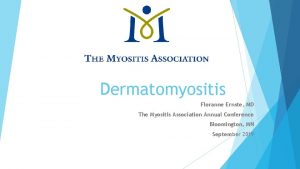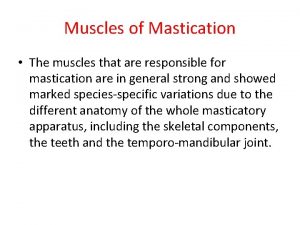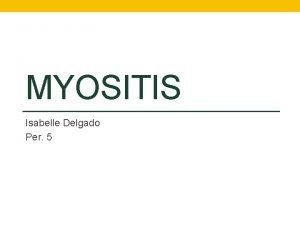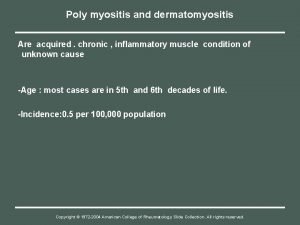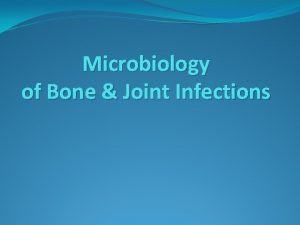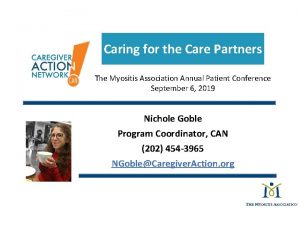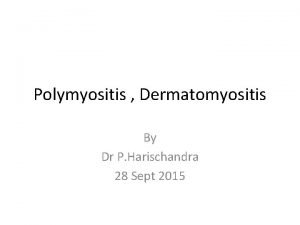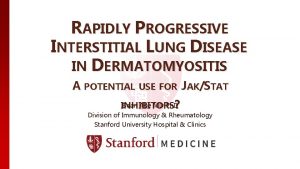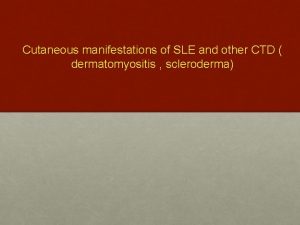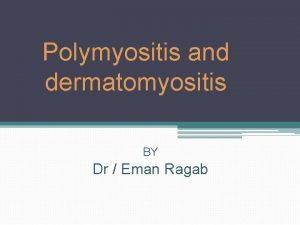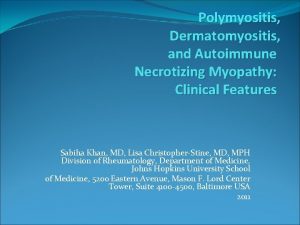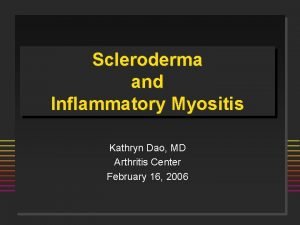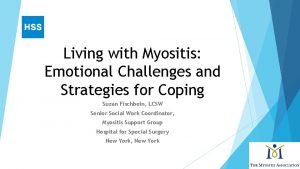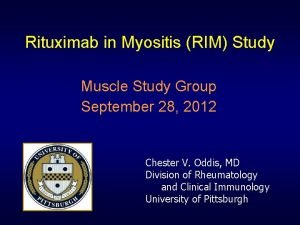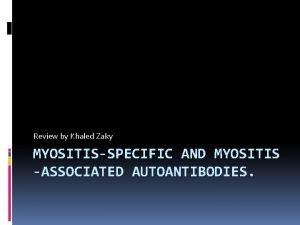Dermatomyositis Floranne Ernste MD The Myositis Association Annual





























































- Slides: 61

Dermatomyositis Floranne Ernste, MD The Myositis Association Annual Conference Bloomington, MN September 2019

Disclosures Octapharma: Genentech: Off-label clinical trial support use: Almost all medications discussed here for treatment are not FDA-approved. 2

Learning Objectives Gain an understanding of the definition of dermatomyositis and how we diagnose it Appreciate how different groups of people are affected Recognize Discuss varied treatment options short and long term prognosis 3

Dermatomyositis: what is it? An autoimmune disease that causes inflammation in your skin and muscle tissue Take a step back: what is autoimmune disease? When the immune system goes awry. How? Your immune system loses “tolerance” to your body’s tissues and certain cells such as your “B cells” and “T cells” and other cells start fighting against your tissues by mounting an inflammatory response. 4

How it may all start. . . Trigger(s): UV light exposure, certain infections, cancer Abnormal Immune System Response (your genes inherited determines your immune response) Organ/Tissue Damage: i. e. skin, muscle, lung, heart, joints 5 Clinically manifests as rashes, muscle weakness, joint pain/swelling

Dermatomyositis: what is it? 3 main types of DM: Amyopathic dermatomyositis Rashes Hypomyopathic dermatmyositis Rashes weak with minor abnormalities in muscle testing, but not clinically Dermatomyositis Rashes without muscle involvement for 6 mos. or longer and muscle weakness Juvenile Dermatomyositis in patients who are diagnosed at 16 years or younger 6

How Common is IT? Not very common Olmsted County Data, population based study Incidence of 9. 63 per million; Prevalence of 21. 42 per 100, 000 Peak age is 45 to 65 years for adults; 5 to 15 years for juvenile DM Female-to-male ratio is 2 -3: 1 In US, African Americans may be more commonly affected than Caucasians in a ratio of 3 -4: 1 Bendewald MJ, Wetter DA, et al. Arch Dermatol. 2010 7

Skin manifestations of dermatomyositis Heliotrope rash: this is a lilac or purple rash affecting the eyelids mainly, but also above and below the eyes Gottron’s papules: purple flat or raised bumps over knuckles, fingers, elbows, knees 8

Skin manifestations of dermatomyositis V-sign: violaceous rash over neck and chest Shawl-sign: violaceous rash over shoulders, upper arms Nailfold abnormalities: cuticule overgrowth, dilated capillary loops 9

Skin manifestations of dermatomyositis Calcinosis: hard skin lumps under skin, subcutaneous tissues, intramuscular tissue: more common in juvenile DM and a small percentage of adult DM 10

Muscle manifestations of dermatomyositis Weakness of proximal muscles (neck/upper arms/thighs/hips) occurs gradually over several months. Can start with difficulty getting in/out of vehicles, climbing stairs, raising your arms overhead with a heavy object in hand, lifting a gallon of milk, carrying your groceries, getting up off the toilet, can’t get up quickly after sitting on floor without help Might feel a soreness in your muscles, rarely severe pain Might notice less muscle tone/bulk, sometimes progresses to “atrophy” You might start to notice difficulty swallowing bulky/dry foods, also known as “dysphagia” 11

What is happening at muscle tissue level? T 2 weighted MRI of thighs 12

13

How do physicians diagnose dermatomyositis? Physical exam: are there DM rashes present, muscle weakness? Lab tests: Do you have elevated muscle enzymes such as creatine kinase, aldolase, AST (SGOT), ALT (SGPT), LDH Electromyogram (EMG) MRI of muscles (sometimes used) Muscle biopsy 14

What do these test results look like? Muscle biopsy Perivascular infiltrate (inflammation) around muscle fascicle Perifascicular Muscle atrophy* microvasculature often involved Necrotic and regenerating fibers seen http: //www. neuro. wustl. edu/neuromuscular/pathol/inflammation. html 15

16

Learning Objectives Gain an understanding of the definition of dermatomyositis and how we diagnose it Appreciate how different groups of people are affected Recognize Discuss varied treatment options short and long-term prognosis 17

Muscle antibodies in dermatomyositis In myositis patients, approximately 60 -70% of adults and children have a myositis autoantibody There are myositis specific antibodies and myositis associated antibodies MSA are usually specific for PM/DM MSA are usually mutually exclusive (not always in my experience). Definition of MAA is broad: found in PM/DM, yet also found in other autoimmune rheumatic diseases. May be part of an overlap syndrome such as SLE and scleroderma. Can co-exist with other MSAs 18

How does DM affect different people? Patient 1 32 year old Hispanic male with itchy red rashes over face, neck, upper chest, arms, hands, fingernails, hips and thighs for 2 years. Presented with significant hand arthritis with swelling of knuckles and wrists Minimal muscle involvement, no significant weakness. Normal CK and other muscle enzymes. Work-up revealed a positive MDA-5 (a myositis antibody) 19

Hand rashes 20

MDA-5 positive antibody Inflammatory arthritis may be severe, often appears “rheumatoid-like. ” Mild myositis. Unique cutaneous characteristics Mucocutaneous ulcerations Tender palmar/digital papules, i. e. “inverse Gottron’s papules” Fiorentino D, Chung L, Zwerner J. J Am Acad Dermatol. 2011; 62: 25 -34. 21

MDA-5 antibody First described 2009 in Japanese/South Korean cohorts of CADM, “clinically amyopathic dermatomyositis” Targets melanoma differentiation association gene 5 protein, a cytoplasmic, viral RNA-specific helicase involved in innate immune response Functions as an “anti-viral” sensor Induces type I interferon responses Can infection trigger this? Associated with rapidly progressing ILD: 50% in Japanese cohort and 22% in USA Sato S, Hoshino K, Satoh T, et al. Arthritis Rheum 2009; 60: 2193 Sato S, Hirakata M, Kuwana M, et al. Arthritis Rheum 2005; 52: 1571 -76. Fiorentino D, Chung L, Zwerner J, et al. J Am Acad Dermatol. 2011; 65: 25 -34. 22

How does DM affect different people? Patient 2 65 yo white male with fevers and weight loss for 6 months develops weakness and difficulty with swallowing. His work-up was notable for high muscle enzymes, abnormal EMG. A muscle biopsy revealed dermatomyositis. Additional work-up included a PET scan and then an upper endoscopy (EGD). 23

24

25

Cancer and Dermatomyositis Cancer and myositis first reported in 1916 with DM and stomach cancer. 25% of DM patients over age 50 may have cancer. Cancer risk is greater in first 3 years of diagnosis (really highest in 1 st year of dx). Patients will usually have features of unusual weight loss, maybe fevers, rapid decline in physical function Some cancers: Lung, breast, ovarian, colon, bladder Stertz G. Polymyositis. Berl Klin Wochenschr. 1916; 53: 489. Gerami P, Schope J, Mc. Donald L, et al. J Am Acad Dermatol. 2006; 54(4): 597 -613. Callen JP. Dermatomyositis and malignancy. Clin Rheum Dis. 1982; 8: 369 -81. Oldroyd et al. Clinical Medicine 2017. 26

How are different people affected? Patient 3. 57 yo white woman presented to clinic with rashes over face, chest, hands inflammatory arthritis involving small joints of hands and dyspnea Skin biopsy revealed “vacuolar interface dermatitis” Chest x-ray showed bi-basilar infiltrates Within 2 weeks of presentation, admitted to ICU with acute respiratory failure Intubated, started on treatment for myositis and lung disease, and after 2 weeks hospitalization, died 27

28

Dermatomyositis and pulmonary manifestations • At least 30% myositis patients have interstitial lung disease (ILD) This may manifest as fatigue and dry cough, shortness of breath that gets worse with minimal activity Patients also may have respiratory muscle weakness Anti-Jo-1 antibody found in 50 -75% myositis pts with ILD • Strong association of ILD with all anti-synthetase antibodies in myositis. No correlation between extent and severity of muscle or skin disease and development of ILD. Secondary pulmonary hypertension can occur due to chronic pulmonary vasoconstriction from hypoxemia. 29

Dermatomyositis and pulmonary manifestations Onset of ILD variable: most of the time occurs at the same time of myositis diagnosis. Course ranges from acute and fulminant ILD, chronic progressive, or asymptomatic (subclinical). Pulmonary function testing reveals restrictive physiology (i. e. FVC ≤ 80%). ILD subtype classified as non-specific interstitial pneumonia (NSIP)—most common, cryptogenic organizing pneumonia (COP), and usual interstitial pneumonia (UIP). Chest imaging shows basilar abnormalities: reticular and ground-glass opacities with loss of lung volume, traction bronchiectasis ILD leads to poor functional status in 30% of patients. 30

31

How are different people affected? Patient 4 7 th grade girl with JDM since age 7 presents with painful subq calcinosis of posterior thighs, left forearm, antecubital fossa (elbow region), buttocks. Hurts to sit down in class. Past treatments: prednisone, methylprednisolone, IVIG, methotrexate, Cell. Cept, rituximab, cyclosporine, and hydroxychloroquine. Exam notable for indurated skin of bilateral thighs, hardened, painful. Underwent several debulking surgeries to remove calcium deposits. 32

How are different people affected? Patient 4 33 T 2 Weighted Coronal Image CT Cross section views

34

How are different people affected? Patient 4 Treated with ultrasound and CT-guided aspirations and resection of posterior calcific masses. Developed complications (5 -10 years’ worth): Chronic, infected fluid collections with sinus drainage Numerous hospitalizations with multiple aspirations, resections and antibiotics’ courses Eventually went off all medications for several years, then recurrence in 20 s of severe calcinosis in a leg, now back on therapy 35

Calcinosis and dermatomyositis Calciniosis occurs from deposition of hydroxyapatite calcium phosphate in the soft tissues. Calcinosis is more frequent in pediatric age groups, such as JDM, occurring 30 -70% of time (associated with aggressive disease and delay in dx), and in adults about 15 -20%. Calcinosis believed to result from intracellular accumulation of calcium secondary to a disruption in cell membranes from trauma/chronic inflammation. Multiple patterns include superficial papules or nodules, deeper nodules or tumors in the dermis or subcutaneous tissue, or diffuse deposits along the myofascial planes which may form an extensive exoskeleton. 36

Dermatomyositis: how does it affect non -white groups? Clinical characteristics: rashes may be subtle and not classic in appearance. Higher risk of calcinosis in non-white children with JDM CK is often higher in African and African-American populations than in white groups Organ involvement may be more severe in African, African. American and Hispanic populations. For example, interstitial lung disease often is more severe and refractory to standard treatment than in white patients Highest rates of hospitalization in non-white DM patients Mortality rates may be higher in women of non-white groups Pinal-Fernandez, Iago et al. 2017. Rheumatology, 56(6); 999 -1007. Hochberg, MC, et al. 1983. Arthritis & Rheumatism, 26 (12); 1465 -1471. Kwa, M. , et al. 2017. Arthritis Care & Research, 69(9); 1391 -1399. Hoeltzel, MF, et al. 2012. Pediatric Rheumatology, 10 (Suppl 1). 37

Learning Objectives Gain an understanding of the definition of dermatomyositis and how we diagnose it Appreciate how different groups of people are affected Recognize Discuss varied treatment options short and long-term prognosis 38

Treatment of DM Should involve a multi-specialty approach with therapy targeted to skin and/or muscle, physical therapy, occupational therapy. There is a lack of large randomized-controlled trials evaluating efficacy of treatments used by experts. Management of extra-muscular organ involvement such as lungs, cardiac is important. Involvement of specialists in multiple medical or surgical disciplines: neurologists, rheumatologists, dermatologists, physical medicine, pulmonologists, cardiologists, general surgeons, orthopedic surgeons is important. 39

My approach to treatment First line: Glucocorticoids (topical +/- oral)+ a steroid sparing agent: Azathioprine (2 mg/kg) Methotrexate (if no severe ILD) Mycophenolate mofetil (standard dosing or 1500 mg twice daily). Glucocorticoid dosing: pulse intravenous daily (3 days) for severe disease (i. e. severe weakness, dysphagia, progressive ILD). Oral glucocorticoids with taper: 1 mg/kg for 4 weeks, taper by 1 -2. 5 -5 mg every 2 -4 weeks pending treatment response and tolerability. Oral taper may slow or stop ~5 -10 mg daily. 40

My approach to treatment Anti-malarials may help skin disease such as hydroxychloroquine, sometimes not adequate alone, and not effective for muscle disease Intravenous immunoglobulin (IVIG) may be used initially or as “bridge therapy” until maintenance immunosuppressives kick in. IVIG 1 -2 gram/kg of ideal body weight. Some patients do not tolerate due to headaches, aseptic meningitis Lower doses may be used. 41

My approach to treatment for severe ILD or other severe organ disease IV or oral cyclophosphamide. Data exists for improvement in Jo-1+ pts with ILD in small series of patients. Cyclosporine A or Tacrolimus Data exists in several small series of patients. I have more experience with tacrolimus, twice daily dosing targeting a trough level of 5 -20 ng/m. L. Monitor for hypertension, renal insufficiency, electrolyte derangements, tremor, peeling rashes. Marie I, Josse S, Hatron PY, et al. Arthritis Care Res (Hoboken); 2013; 65: 800 -8. Oddis CV, Sciurba FC, Strazl TE. Lancet. 1999; 353: 1762 -63. Wilkes MR, Sereika SM, Fertig N, et al. Arth Rheum. 2005; 52: 2439 -2446 42

My approach to treatment for refractory myositis disease Rituximab 1000 mg X 2 and repeat every 6 months; doses may be reduced in subsequent infusions “RIM” trial of refractory juvenile/adult IIM, didn’t meet endpoints, but 83% met definition of improvement. Refractory IIM patients with strongly positive autoantibodies (i. e. Jo-1) may be more responsive to rituximab (shorter time to improvement). Interestingly, autoantibody titers decrease after rituximab suggesting a correlation with clinical response. Oddis CV, Reed AM, Aggarwal R, et al. Arthritis Rheum. 2013; 65: 312 -24. Aggarwal R, Bandos A, Reed AM, et al. Arthritis Rheumatol. 2014; 66: 740 -9 43

What about calcinosis? Numerous therapies tried with varying or no success: Calcium channel blockers (diltiazem, amlodipine) Bisphonates (alendronate) Colchicine IVIG Methotrexate Steroids Biologic medications *Topical sodium thiosulfate (useful for small calcific deposits under skin) IV sodium thiosulfate (experimental) Surgical resection/debulking 44

Newer treatments on horizon IL-6 blockers JAK inhibitors Tofacitinib-recalcitrant DM Abatacept Lenabasum for skin disease Sifalimumab Anti-IFN alpha monoclonal ab 45 Tjarnlund A, Tang Q, Wick C et al. Ann Rheum Dis 2018; 77: 55 -62

Physical therapy Beneficial. Effective on muscle performance, aerobic capacity and overall health. Exercise may downregulate genes related to inflammation. “If you don’t use it, you lose it. ” I try to engage patients to meet with physical therapist early for stretching exercises and submaximal strengthening exercises. Good to prevent muscle damage leading to muscle atrophy, preserve joint range of motion. Safety assessment may be required if falls are common and gait aids may be appropriate. Munters Alemo L, Alexanderson et al. Curr Rheumatol Rep 2014; 16 (7) 429 46

How is treatment response assessed? Core set measures developed. Manual muscle strength testing (MMT) Functional assessment – HAQ, CHAQ, FI Global assessment Physician Patient/parent Assessment of extra-muscular activity MDAAT/MITAX or CMAS Muscle enzymes - CK, aldolase, AST, ALT, LDH Miller FW, Rider LG, Chung YL, et al. Rheumatology 2001; 40: 1262 -73 47

My assessment of treatment response Improvement or stabilization of muscle strength on physical exam. Normalization of muscle enzymes: CPK, aldolase, LDH, AST, ALT. I may check serial EMGs or muscle MRIs. Improvement of other organ systems such as pulmonary and cardiac: Serial PFTs Serial chest imaging, preferably high resolution CT imaging. Echocardiogram to screen for heart failure and pulmonary hypertension 48

Management of side effects and other concerns. If active skin disease, the sun is no longer your friend. Concern for UV radiation exposure may trigger or exacerbate skin disease; increase risk for skin cancer Certain Wear protective clothing (wide brimmed hat, long sleeves if appropriate) Some medications may enhance sunlight effect patients buy UV photo-protective clothes, expensive Wear sunscreen and reapply at least every 2 hours even on a cloudy day (SPF of 50 or higher) 49

Management of side effects and other concerns. Screen for latent TB, HIV, chronic hepatitis B and C infections. Check vaccination status including influenza, Shingrix and pneumococcal vaccines (PCV-13, PPSV-23). Screen for diabetes, hyperlipidemia, hypertension, osteoporosis at baseline. Use calcium/vitamin D when on steroids. If osteoporosis develops, use anti-resporptive agent or other agent if appropriate. 50

Management of side effects and other concerns. Counsel women of childbearing age and recommend birth control as appropriate. Consider using pneumocystis prophylaxis for all patients with moderate/severe ILD on immunosuppressives (expert opinion). Treat infectious complications, i. e. herpes zoster, influenza, pneumonias, as they arise and stop or reduce immunosuppressives for short term, if needed. 51

Management of side effects and other concerns If reflux is present, treat. Emphasize lifestyle changes Elevation of head of bed, avoidance of alcohol and smoking, no large meals late at night, etc… Treatment with proton pump inhibitors/H 2 blockers. Uncontrolled GERD may affect underlying interstitial lung disease, i. e. “silent microaspiration, ” may trigger cough and exacerbate underlying pulmonary disease. If swallowing difficulty is present, arrange for swallowing studies and visit with a swallowing therapist 52

Management of side effects and other concerns *Steroid myopathy Thin skin and poor wound healing Hypertension High cholesterol Significant weight gain Some patients develop obstructive sleep apnea leading to fatigue Your body changes: redistribution of fat 53

Learning Objectives Gain an understanding of the definition of dermatomyositis and how we diagnose it Appreciate how different groups of people are affected Recognize Discuss varied treatment options short and long-term prognosis 54

Short-term prognosis (1 -5 years): what I have observed Depends on severity of disease and number of organs involved. Patients with greatest muscle reserve at baseline and who exercise tend to regain muscle strength faster That being said, I generally tell patients it will take up to a year and longer to return back to baseline muscle strength Some patients never regain muscle strength (older in age, have other organ systems involved such as lung, or experienced severe infections or cancer) With treatment and compliance, you will get better. But there may be periods where flares can occur 55

Long-term prognosis (after 5 years) Generally, as long as you stay on treatment and you respond well, your life span is not generally shortened However, if you have major and severe organ involvement such as lung or cardiac, your life span may be shortened Your rheumatologist/neurologist will determine if medications need to be reduced/tapered, pending your response I tend to keep patients on their medications with intent for lifelong therapy (most of the time, DM has a polyphasic course) *Prognosis may be guarded if you have cancer-associated myositis 56

What do the studies show for prognosis? Historical studies of IIM patients with ILD, 5 year survival rate 60% (similar to idiopathic pulmonary fibrosis). The lower the %FVC at baseline, the likelihood of lung deterioration over long-term. The more acute the lung disease, the more likely lung function deteriorates UIP pattern of pneumonia associated with lower survival Yet, recent studies suggest survival rate has improved. One study in patients with ILD, after median of 53 mos. follow-up, 1 year survival (94. 4%), 3 year survival (90. 4%), 5 year survival 86. 5%. Relapses are common, usually seen if patients treated only with glucocorticoids Douglas WW, Tazelaar HD, Hartman TE, et al. Am J Respir Crit Care Med. 2001; 164: 1182 -5 Marie I, Hachulla E, Cherin P, et al. Arthritis Rheum. 2002; 47: 614 -22. Marie I, Josse S, Hatron PY, et. Al. Arthritis Care & Research. 2013; 800 -808 Fujisawa T, Hozumi H, Kono M, et al. Respiratory Investigation. 2017; 130 -137. 57

What do studies show for long-term prognosis? Study in Italy looked at 91 patients (43 with PM and 48 with DM) 24% of the 91 patients died after a median follow up of 8. 7 years Predictors for higher mortality: Males [HR 2. 4], heart involvement [1. 8], interstitial lung disease [HR 2. 3], and arthritis [HR 1. 8] Higher mortality documented for patients treated with steroids [HR 2. 3] or immunosuppressants [HR 2. 1] when compared to patients treated with immunoglobulins 58 Danieli, MG, Gambini S, Pettinari L, et al. Impact of treatment on survival in polymyositis and dermatomyositis. A single-centre long-term follow-up study. Autoimmunity Reviews 13 (2014); 1048 -54.

What do studies show for prognosis overall? Good news: in this Italian population, the overall survival rate for DM patients were 95% at 5 years and 92% at 10 years Higher mortality for cancer-associated myositis 5 year survival rate of 69. 2% (CI 37. 3 -87. 2) 10 year survival rate of 60. 6% (CI 29. 4 -81. 4) Take home: There is an overall improvement in survival over several decades due to earlier diagnosis and treatment Danieli, MG, Gambini S, Pettinari L, et al. Impact of treatment on survival in polymyositis and dermatomyositis. A single-centre long-term follow-up study. Autoimmunity Reviews 13 (2014); 1048 -54. 59

Summary Dermatomyositis is an autoimmune inflammatory muscle disease mainly characterized by skin rashes and muscle weakness DM is heterogenous in presentation and affects people differently Treatment should involve a multi-specialty approach with involvement of multiple specialists Short and long term prognosis is affected by treatment response, number of organ systems involved, presence of cancer and severity of disease. 60

Questions? Thank you for your time and attention! 61
 Dermatomyositis
Dermatomyositis Muscles of the mastication
Muscles of the mastication Imacs tis
Imacs tis Isabelle delgado
Isabelle delgado Symmetryical
Symmetryical Dermatomyositis hypersensitivity type
Dermatomyositis hypersensitivity type American psychiatric association annual meeting 2020
American psychiatric association annual meeting 2020 Travel health insurance association annual conference
Travel health insurance association annual conference Chó sói
Chó sói Thẻ vin
Thẻ vin Thể thơ truyền thống
Thể thơ truyền thống Các châu lục và đại dương trên thế giới
Các châu lục và đại dương trên thế giới Từ ngữ thể hiện lòng nhân hậu
Từ ngữ thể hiện lòng nhân hậu Diễn thế sinh thái là
Diễn thế sinh thái là Frameset trong html5
Frameset trong html5 Ví dụ giọng cùng tên
Ví dụ giọng cùng tên Vẽ hình chiếu vuông góc của vật thể sau
Vẽ hình chiếu vuông góc của vật thể sau Làm thế nào để 102-1=99
Làm thế nào để 102-1=99 Khi nào hổ con có thể sống độc lập
Khi nào hổ con có thể sống độc lập Lời thề hippocrates
Lời thề hippocrates Chụp tư thế worms-breton
Chụp tư thế worms-breton đại từ thay thế
đại từ thay thế Quá trình desamine hóa có thể tạo ra
Quá trình desamine hóa có thể tạo ra Công thức tiính động năng
Công thức tiính động năng Thế nào là mạng điện lắp đặt kiểu nổi
Thế nào là mạng điện lắp đặt kiểu nổi Dạng đột biến một nhiễm là
Dạng đột biến một nhiễm là Bổ thể
Bổ thể Vẽ hình chiếu đứng bằng cạnh của vật thể
Vẽ hình chiếu đứng bằng cạnh của vật thể Biện pháp chống mỏi cơ
Biện pháp chống mỏi cơ độ dài liên kết
độ dài liên kết Các môn thể thao bắt đầu bằng tiếng nhảy
Các môn thể thao bắt đầu bằng tiếng nhảy Khi nào hổ mẹ dạy hổ con săn mồi
Khi nào hổ mẹ dạy hổ con săn mồi Thiếu nhi thế giới liên hoan
Thiếu nhi thế giới liên hoan Chúa yêu trần thế
Chúa yêu trần thế điện thế nghỉ
điện thế nghỉ Một số thể thơ truyền thống
Một số thể thơ truyền thống Trời xanh đây là của chúng ta thể thơ
Trời xanh đây là của chúng ta thể thơ Các số nguyên tố là gì
Các số nguyên tố là gì Tỉ lệ cơ thể trẻ em
Tỉ lệ cơ thể trẻ em Fecboak
Fecboak Các châu lục và đại dương trên thế giới
Các châu lục và đại dương trên thế giới Thế nào là hệ số cao nhất
Thế nào là hệ số cao nhất Sơ đồ cơ thể người
Sơ đồ cơ thể người ưu thế lai là gì
ưu thế lai là gì Tư thế ngồi viết
Tư thế ngồi viết đặc điểm cơ thể của người tối cổ
đặc điểm cơ thể của người tối cổ Cái miệng xinh xinh thế chỉ nói điều hay thôi
Cái miệng xinh xinh thế chỉ nói điều hay thôi Hình ảnh bộ gõ cơ thể búng tay
Hình ảnh bộ gõ cơ thể búng tay Mật thư anh em như thể tay chân
Mật thư anh em như thể tay chân Tư thế ngồi viết
Tư thế ngồi viết Kantar annual report
Kantar annual report Mid day meal annual performa haryana
Mid day meal annual performa haryana Payback period formula
Payback period formula Logbook entry examples
Logbook entry examples Annuity
Annuity Tamborine mountain annual rainfall
Tamborine mountain annual rainfall Fte annual salary
Fte annual salary Effective versus nominal interest rates
Effective versus nominal interest rates Cic annual report 2019
Cic annual report 2019 How to calculate moving annual total
How to calculate moving annual total Problem 10-18 calculating eac..
Problem 10-18 calculating eac.. Job order cost system
Job order cost system
